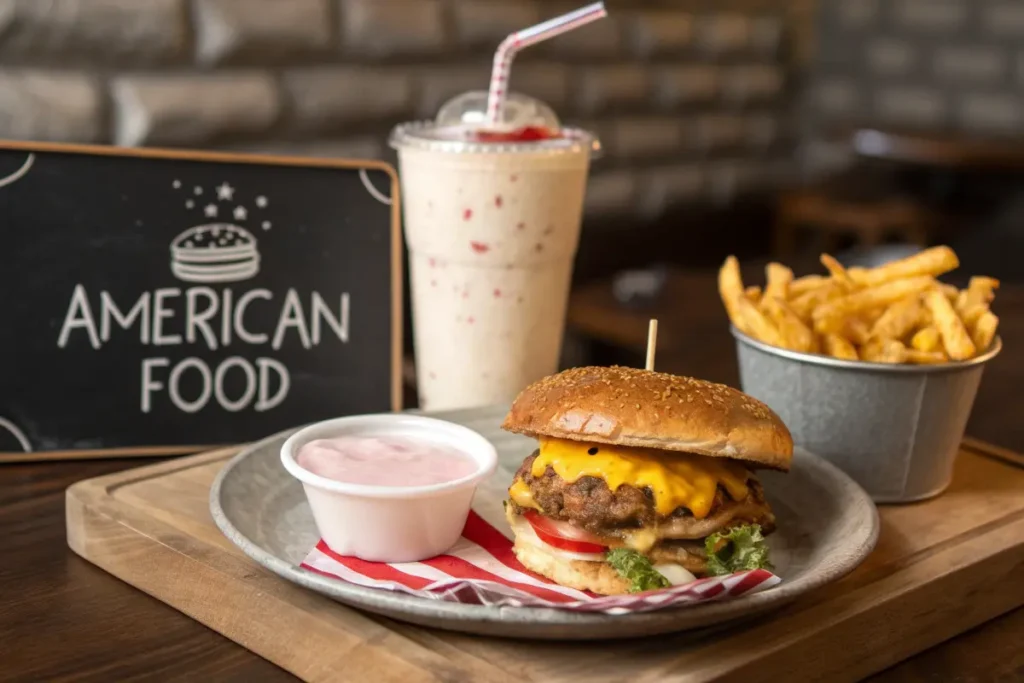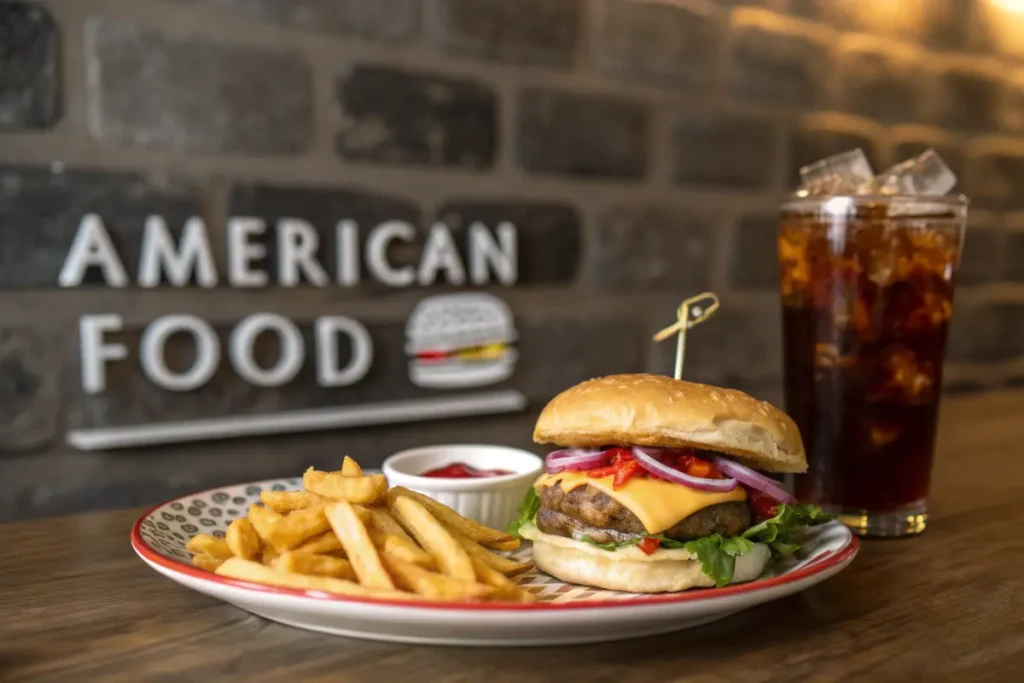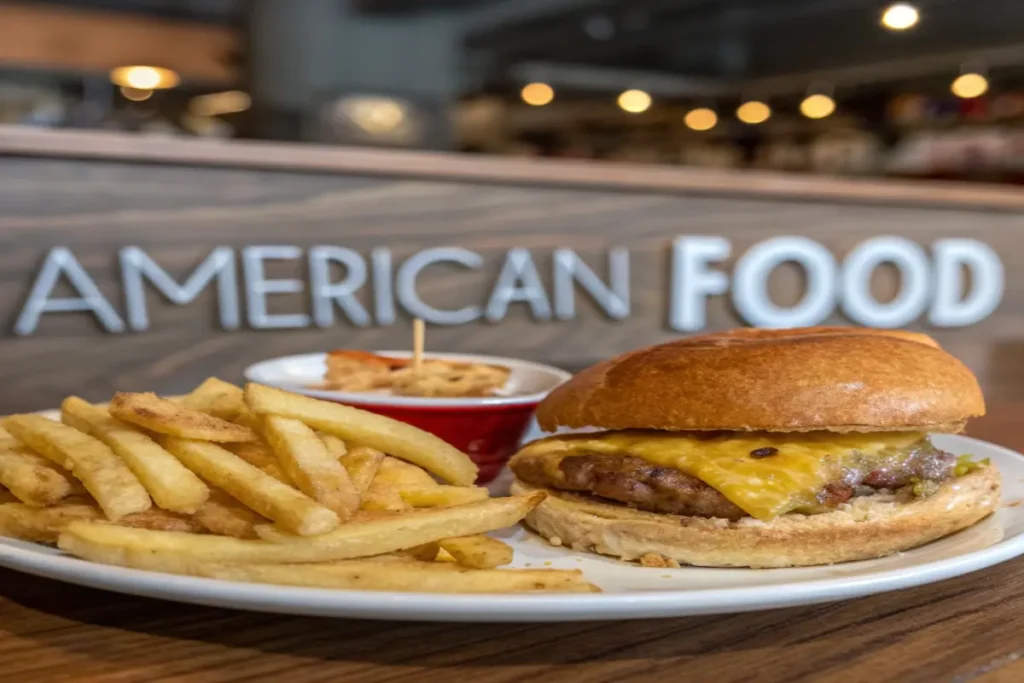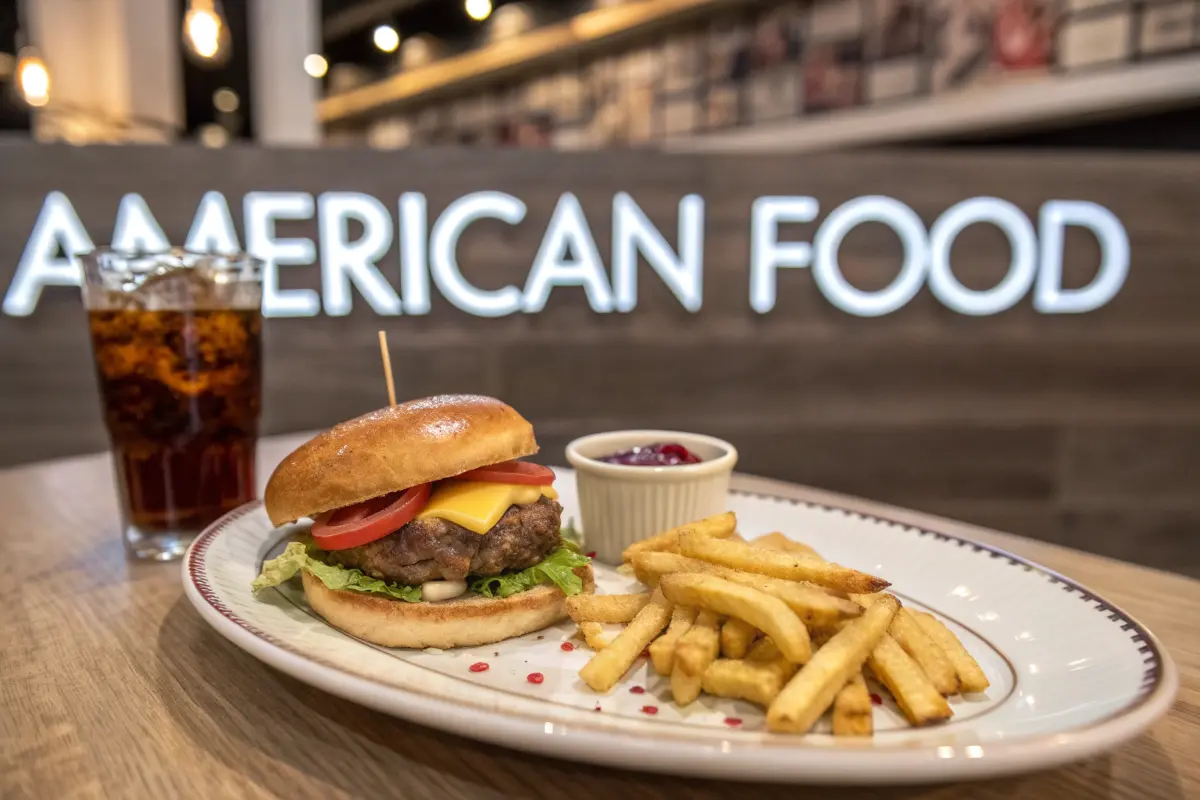American food is a melting pot of flavors, cultures, and traditions, showcasing a rich culinary heritage that has evolved over centuries. From the smoky allure of barbecue to the comforting charm of apple pie, American cuisine reflects the diverse backgrounds and innovative spirit of its people. In this comprehensive guide, we delve into the essence of American food, its history, iconic dishes, and the cultural significance it holds today.
The Evolution of American Cuisine
American cuisine is a melting pot of flavors, history, and traditions. Its foundation was laid by Native Americans, whose resourceful use of indigenous ingredients like corn, beans, and squash established the building blocks for many recipes. These “Three Sisters” were not just ingredients; they were symbols of sustainability and harmony with nature.
As European settlers arrived, they introduced new techniques and ingredients, including wheat, dairy, and various meats. These additions expanded the culinary landscape and set the stage for fusion cuisine. However, the story of American food doesn’t end there. Communities from Africa, Asia, and Latin America brought their rich flavors, spices, and innovative cooking methods. These contributions transformed the cuisine into a vibrant tapestry of taste.
Indigenous Foundations: The Birthplace of American Food
Long before modern culinary trends, Native Americans mastered the art of using what nature provided. They relied on local resources, creating dishes that were nutritious and flavorful. Some notable contributions include:
- Corn-based dishes: Cornbread, grits, and tortillas owe their origins to indigenous techniques.
- Beans and legumes: Often paired with corn, they formed protein-rich meals.
- Game meats and fish: Venison, bison, and freshwater fish were staples of Native diets.
Their holistic approach to food inspired sustainable practices still relevant today.
Immigrant Influences: A Kaleidoscope of Flavors
As waves of immigrants arrived in America, they brought culinary traditions that shaped the nation’s palate. Each group left an indelible mark:
- European settlers introduced baking techniques, dairy products, and classic bread recipes.
- African slaves contributed soul food staples like okra, yams, and fried dishes.
- Asian immigrants brought bold flavors, from soy sauce to ginger, influencing dishes like stir-fry and noodle soups.
- Latin American communities added a fiery zest with chili peppers, cilantro, and lime-infused recipes.
This global influence is the backbone of what we now celebrate as American cuisine.

The Impact of Regional Diversity
America’s vast geography and diverse population have created distinct regional cuisines. Each region offers something unique, reflecting its history, climate, and cultural influences.
Northeastern Cuisine: A Maritime Heritage
The Northeastern United States boasts a culinary tradition rooted in the sea. Coastal states like Maine and Massachusetts thrive on seafood, offering dishes like:
- Clam chowder: A creamy soup loaded with clams, potatoes, and onions.
- Lobster rolls: Buttered rolls stuffed with tender lobster meat.
- Crab cakes: Popular in Maryland, these savory patties showcase fresh crab.
These dishes highlight the region’s reliance on fresh, local ingredients and its maritime history.
Southern Comfort: Flavors of the South
The South is synonymous with comfort food. Dishes here are rich, hearty, and often fried. Some highlights include:
- Fried chicken: Seasoned to perfection and fried until golden brown.
- Collard greens: Slow-cooked greens flavored with smoked meats.
- Gumbo and jambalaya: Iconic Cajun and Creole dishes bursting with bold spices.
- Cornbread and biscuits: Staple sides that complete any Southern meal.
The South’s food culture reflects its deep roots in agriculture and tradition.
Midwestern Staples: Heartland Hearty Meals
Known as “America’s Breadbasket,” the Midwest excels in producing grains, dairy, and meat. It’s no surprise that its cuisine revolves around hearty, family-style meals like:
- Casseroles: Creamy, baked dishes often featuring pasta or potatoes.
- Deep-dish pizza: Originating in Chicago, this thick-crusted pie is packed with toppings.
- Meatloaf: A nostalgic classic served with mashed potatoes.
This region’s cuisine focuses on simplicity and sustenance, reflecting its agricultural roots.
Western Innovations: Where Tradition Meets Trends
The Western U.S. is known for its innovative approach to food. California’s farm-to-table movement emphasizes fresh, local produce, while Texas showcases its love for barbecue and Tex-Mex. Notable dishes include:
- Barbecue brisket: Slow-cooked to perfection, with smoky flavors.
- Tex-Mex classics: Fajitas, nachos, and enchiladas blend Mexican and American influences.
- Avocado toast: A modern favorite born in California.
The West’s culinary diversity mirrors its openness to experimentation and multiculturalism.

Iconic American Dishes That Define the Nation
American cuisine is about more than just food; it’s a reflection of culture, celebration, and community. Let’s explore some iconic dishes that capture the essence of American food.
Hamburgers and Hot Dogs
- Hamburgers: A juicy patty topped with cheese, lettuce, and condiments of your choice.
- Hot dogs: A nostalgic favorite served at ballgames and barbecues.
These dishes symbolize innovation and indulgence, making them quintessentially American.
Barbecue: A Regional Art Form
From Texas to the Carolinas, barbecue is celebrated in many forms:
- Texas brisket: Smoky, tender, and full of flavor.
- Pulled pork: North Carolina’s tangy specialty.
- Kansas City ribs: Glazed with sweet, smoky sauces.
Barbecue is more than a meal—it’s a tradition that brings communities together.
Apple Pie: A Sweet Symbol of America
This classic dessert combines spiced apples, flaky crusts, and a touch of nostalgia. Paired with vanilla ice cream, it’s a comforting treat for any occasion.
Fried Chicken: Crispy and Flavorful
The South’s contribution to global cuisine, fried chicken, is beloved for its crispy coating and tender meat. It’s a dish perfected over generations.
Clam Chowder: Comfort in a Bowl
This creamy soup is a Northeastern treasure, combining fresh clams, potatoes, and a rich broth. It’s a must-try for seafood lovers.
The Cultural Significance of American Food
American food is more than sustenance—it is a cultural touchstone that mirrors the nation’s melting pot identity. It showcases an ever-evolving blend of traditions, innovations, and global influences. Here’s a closer look at how American cuisine reflects its dynamic story:
1. Food as a Unifier
Food in America goes beyond the plate, serving as a means of celebration, connection, and tradition. Thanksgiving meals, Fourth of July barbecues, and Sunday family dinners all highlight the unifying power of shared dishes. These moments create a sense of belonging across a diverse population.
Modern Trends in American Cuisine
American food is continually reinventing itself, adapting to modern values and trends:
- Sustainability: Farm-to-table practices focus on reducing waste and supporting local agriculture.
- Health-Conscious Choices: Plant-based proteins, organic produce, and mindful eating habits are driving food innovation.
- Resurgence of Tradition: Techniques like pickling, fermenting, and sourdough baking are making a comeback.
- Fusion Flavors: Blending global influences has led to boundary-pushing dishes like sushi tacos and kimchi burgers.
Exploring American Cuisine
To experience the depth of American food:
- Visit iconic eateries offering local staples like deep-dish pizza or shrimp and grits.
- Experiment with regional recipes that highlight fresh, seasonal ingredients.
- Embrace street food and food trucks that often serve fusion creations.
Global Influences on American Food
1. Immigrant Contributions:
Italian, Chinese, and Mexican cuisines have seamlessly integrated into the American food scene. Over time, traditional dishes have evolved, giving rise to unique versions like Tex-Mex, General Tso’s chicken, and Chicago-style pizza.
2. Fusion Cuisine:
Innovative dishes such as Korean BBQ tacos and ramen burgers embody America’s culinary creativity. These hybrids celebrate diversity and demonstrate how different cultures shape the nation’s food landscape.
3. Ingredient Adoption:
Items like quinoa, matcha, and za’atar, once niche, are now staples. This reflects an ever-adventurous palate and America’s receptiveness to global culinary trends.
American cuisine is not static; it’s a living, breathing tapestry, constantly enriched by its people and their stories.erent cultures through food.
American Food in Pop Culture
Food in Films and TV
American food often plays a starring role in movies and television. Think of the iconic diner scenes with milkshakes and burgers in classic films or the Thanksgiving feasts depicted in countless sitcoms. These moments highlight the cultural importance of food in storytelling.
Cooking Shows and Competitions
Cooking competitions like “MasterChef” and “Top Chef” celebrate American food’s versatility and innovation. These shows inspire viewers to experiment with recipes and appreciate the artistry behind the dishes.
Food Trends on Social Media
Platforms like Instagram and TikTok have popularized trends such as rainbow bagels, freakshakes, and loaded fries. These visually striking foods captivate audiences and contribute to the evolution of American food culture.
The Role of Festivals in American Food Culture
Food-Focused Events
Festivals like the National Cherry Festival in Michigan or the Maine Lobster Festival highlight regional specialties and bring communities together. These events celebrate local ingredients, cooking techniques, and culinary traditions.
State Fairs
State fairs are synonymous with indulgent foods like corn dogs, funnel cakes, and deep-fried everything. They provide a platform for showcasing quirky, over-the-top creations that capture the essence of fun and innovation in American cuisine.
Cultural Food Festivals
Events like the Greek Food Festival or Chinese New Year celebrations offer opportunities to explore international flavors within the American context. These festivals foster cultural exchange and appreciation through food.

Sustainability in American Food Practices
Farm-to-Table Movement
The farm-to-table movement emphasizes sourcing ingredients directly from local farms. This practice supports sustainability, reduces carbon footprints, and ensures fresher, more flavorful meals.
Waste Reduction
Efforts to reduce food waste are gaining traction. Restaurants and households alike are embracing practices like composting, repurposing leftovers, and donating surplus food to charities.
Organic and Ethical Choices
Consumers are increasingly prioritizing organic produce, free-range meats, and fair-trade products. These choices reflect a growing awareness of environmental and ethical concerns in food production.
FAQs
What is traditional American food?
Traditional American food includes classics like hamburgers, hot dogs, fried chicken, apple pie, barbecue ribs, and meatloaf. Many dishes draw inspiration from global cuisines, blended with regional flavors, creating a unique culinary identity.
What food is 100% American?
Cornbread, buffalo wings, clam chowder, and s’mores are quintessentially American, originating entirely in the U.S. They showcase the country’s agricultural abundance and creative adaptations of available ingredients.
What is the popular food in the USA?
Burgers, pizza, fried chicken, and tacos are some of the most popular foods in the U.S. These dishes are loved for their convenience, bold flavors, and versatility in preparation.
What is American daily food?
Typical daily American meals include cereal or eggs for breakfast, sandwiches or salads for lunch, and hearty dinners like pasta, steak, or casseroles. Snacking on chips or cookies is also common.
What is American national food?
While the U.S. doesn’t have an official national food, hamburgers are widely regarded as a symbol of American cuisine, embodying the country’s love for casual and customizable meals.
What is USA morning food?
Breakfast favorites in the U.S. include pancakes, waffles, scrambled eggs, bacon, and bagels. Regional options like biscuits and gravy or avocado toast are also widely enjoyed.
What food is the most American?
Apple pie is often considered the most American food, symbolizing patriotism and tradition. Other contenders include barbecue ribs, cheeseburgers, and fried chicken.
Which country has the best food?
Food preferences are subjective, but countries like Italy, Japan, France, and Mexico are celebrated globally for their exceptional cuisines, offering unique flavors and culinary traditions.
What is America’s favorite fast food?
America’s favorite fast food is often considered hamburgers, with McDonald’s leading the charge. Other favorites include fried chicken, pizza, and tacos from chains like KFC, Domino’s, and Taco Bell.
What is the 10 most popular food in the world?
Globally loved foods include pizza, sushi, burgers, pasta, fried chicken, tacos, ice cream, chocolate, rice dishes, and bread, offering a diverse range of tastes and traditions.
What is USA food for dinner?
Common American dinners include roast chicken, pasta dishes, steak, casseroles, or burgers. Many meals are accompanied by sides like mashed potatoes, salads, or steamed vegetables.
Conclusion
American cuisine is a dynamic and ever-evolving tapestry that weaves together history, culture, and innovation. It reflects the nation’s diverse heritage, honoring its roots in indigenous traditions while embracing the influences of countless immigrant communities. From regional specialties like Southern barbecue and New England clam chowder to modern trends like farm-to-table dining and fusion cuisine, American food offers something for every palate and preference.
This culinary landscape isn’t just about what’s on the plate; it’s about the stories, traditions, and connections that come with it. Food plays a central role in celebrations, gatherings, and even shaping national identity, uniting people through shared flavors and experiences. Whether it’s indulging in a slice of apple pie, experimenting with global ingredients in your kitchen, or savoring iconic dishes at a local festival, every bite tells a story of creativity and heritage.
Now is the time to dive deeper into the richness of American cuisine. Explore regional flavors, try your hand at making a classic dish, or embrace the exciting innovations emerging in today’s food culture. Celebrate the diversity and history of American food by making it part of your journey, one delicious experience at a time.

